ASEAN Journal on Science and Technology for Development
Abstract
An immersion experiment was conducted in the Manila South Harbor to document the development of sessile biofouling communities. Test panels were submerged below the sea surface in April 2012 for short- (one and three months) and long-term (one year) exposures in seawater, then foauling types and occurrences were scored based on digital images of panel surfaces. The short-term immersed panels were found with significant cover of soft fouling (undet.), slime, and the invasive Balanus (=Amphibalanus) amphitrite. These also filled the long-term immersed panels, although some fell off due to mortality from crude oil smothering. Perna viridis, native but also invasive, successfully established and then dominated the fouling cover by the 12th month (April 2013). Oysters, bryozoans (Watersipora sp.), colonial tunicates, polychaetes (Hydroides sp.), and green algae contributed minor to fouling cover. These fouling communities in the Manila South Harbor consisted of organisms that were cosmopolitan in port waters of SE Asia. A similar study must be carried out in other major ports of the country and then compared.
Publication Date
7-17-2020
Recommended Citation
M.E., Nacorda Hildie; M., Austero Nero; R., Pagdilao Cesar; Siang, Tan Koh; and V., Azanza Rhodora
(2020)
"Marine Biofouling Communities of Manila South Harbor, Philippines,"
ASEAN Journal on Science and Technology for Development: Vol. 35:
No.
1, Article 17.
DOI: https://doi.org/10.29037/ajstd.481
Available at:
https://ajstd.ubd.edu.bn/journal/vol35/iss1/17

